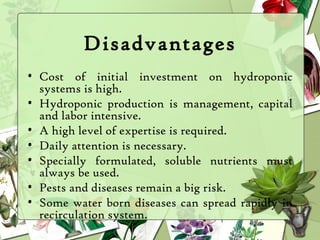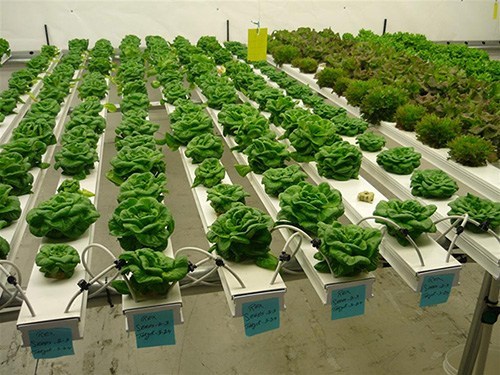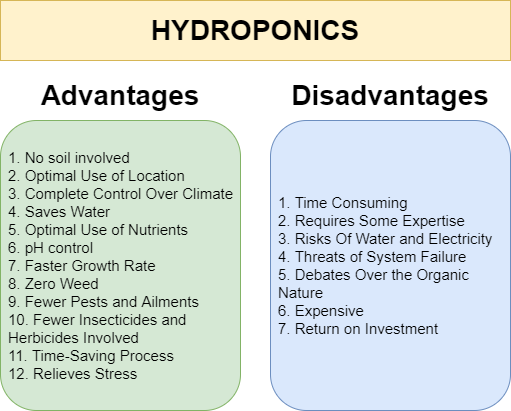Hydroponics is an innovative way to grow plants without soil. It offers many benefits.
But what about the drawbacks? While hydroponics can be efficient, it’s not without its challenges. Understanding these disadvantages is crucial before diving into this method. Hydroponics requires precise monitoring and control, which can be time-consuming. Initial setup costs can be high, making it less accessible for everyone.
There’s also a learning curve; mistakes can impact plant health quickly. Additionally, technical issues or power outages can disrupt the system, leading to potential crop loss. By knowing these disadvantages, you can better decide if hydroponics suits your gardening needs. This blog will explore these challenges in detail, helping you make an informed choice.

Credit: matsuoutdoorsmanshow.com
Initial Investment Costs
Hydroponics is a popular method for growing plants without soil. While it offers many benefits, it also has some drawbacks. One of the main disadvantages is the initial investment costs. This can be a significant barrier for beginners and small-scale farmers. Let’s delve into some specific areas that contribute to these high costs.
Equipment Expenses
Setting up a hydroponic system requires specialized equipment. This equipment can be costly. Here are some of the necessary items:
- Grow Lights: Essential for providing the right light spectrum.
- Pumps and Tubes: Needed to circulate water and nutrients.
- Containers and Trays: Used to hold the plants and nutrient solution.
- Nutrient Solutions: Specific nutrients needed for plant growth.
These items are critical for the system to function properly. Each piece of equipment has its own cost, which adds up quickly.
Setup And Installation
The setup and installation process is complex. It often requires professional help. This adds to the initial investment costs. Here are some factors to consider:
- Space Preparation: Preparing the space for the system can be labor-intensive.
- System Assembly: Assembling the hydroponic system requires technical skills.
- Initial Testing: Testing the system to ensure it works correctly.
Each of these steps involves both time and money. This makes the initial setup costly and time-consuming.
In summary, the initial investment costs in hydroponics can be high. The expenses for equipment and the complexity of setup and installation are major factors. Understanding these costs can help you make informed decisions about starting a hydroponic system.

Credit: www.vanqled.com
Technical Knowledge Required
Hydroponics offers many benefits, but it does come with challenges. One of the biggest hurdles is the technical knowledge required. This can be a significant disadvantage for new growers. Understanding how to set up and maintain a hydroponic system can be complex. Let’s dive deeper into two key areas: system maintenance and troubleshooting issues.
System Maintenance
Maintaining a hydroponic system is vital. It requires regular attention. Key tasks include:
- Monitoring water pH levels
- Checking nutrient solutions
- Cleaning the system components
Each task demands a certain level of expertise. For instance, improper pH levels can harm plant health. Adjusting nutrient solutions needs an understanding of plant requirements. Cleaning prevents algae buildup, which can block water flow. Mistakes in these areas can lead to system failure.
Troubleshooting Issues
Troubleshooting is another critical aspect. Hydroponic systems can face many problems. Common issues include:
- Root rot
- Algae growth
- Pest infestations
Identifying and solving these issues requires knowledge. For example, root rot often occurs due to overwatering. Addressing this involves adjusting water flow and oxygen levels. Algae can thrive in light-exposed water, requiring changes in light management. Pest infestations need prompt action to prevent crop loss.
Having the right tools and understanding is crucial. Without proper technical knowledge, maintaining and troubleshooting a hydroponic system becomes daunting. This can discourage beginners from pursuing hydroponics.
Dependency On Electricity
Hydroponics is a method of growing plants without soil. Instead, it uses a nutrient-rich water solution. While hydroponics offers many benefits, there are also some disadvantages. One of the main drawbacks is the dependency on electricity. This reliance can create significant challenges for growers.
Power Outages
Hydroponic systems need electricity to operate. They power pumps, lights, and climate control systems. Power outages can stop these systems from working. Without power, plants may not receive nutrients or light. This can lead to poor growth or even plant death.
To manage this risk, some growers use backup generators. Others invest in battery systems. These solutions can help, but they add extra costs.
Energy Costs
Running a hydroponic system can be energy-intensive. Lights, pumps, and heaters all use electricity. These energy costs can add up quickly. In some areas, high electricity rates can make hydroponics expensive.
Let’s look at an example of typical energy usage:
| Component | Energy Consumption |
|---|---|
| Grow Lights | 400-1000 watts |
| Water Pumps | 30-50 watts |
| Heaters | 100-300 watts |
To reduce energy costs, some growers use energy-efficient equipment. Others use timers to limit the operation of lights and pumps. Renewable energy sources, like solar panels, can also help.
Water And Nutrient Management
Water and nutrient management is critical in hydroponics. It ensures plants get necessary nutrients. But, it also presents challenges. Proper management is key to healthy plant growth. Mismanagement can lead to poor results. Let’s explore some common issues.
Nutrient Solution Preparation
Preparing the nutrient solution requires precision. The right balance of nutrients is vital. Too much or too little affects plant health. Beginners often struggle with this task. It needs careful measurement and mixing.
Monitoring the solution regularly is important. Nutrient levels can change over time. Regular checks help maintain balance. This task can be time-consuming.
Water Quality Control
Water quality affects plant growth. Poor quality water harms plants. It may contain harmful chemicals or microorganisms. Using clean water is essential.
Testing water quality is necessary. This ensures it is safe for plants. Sometimes, water treatment systems are needed. These can be expensive and require maintenance.
System Failures And Risks
Hydroponics offers many benefits, yet it comes with certain risks. System failures can occur, causing significant issues for growers. Understanding these risks can help in managing them effectively.
Pump Failures
Pump failures are a common problem in hydroponic systems. The pump is crucial for circulating nutrients. If the pump stops working, plants can suffer. They may not get the nutrients they need. This can lead to poor growth or even plant death. Regular maintenance can help prevent pump failures. Always have a backup pump ready.
Clogged Tubing
Clogged tubing can also cause problems in hydroponic systems. Nutrient solutions can build up, causing blockages. These blockages stop the flow of nutrients to the plants. As a result, plants can become stressed and unhealthy. Cleaning the tubing regularly can prevent clogs. Using filters can also help keep the system clear.

Credit: www.linkedin.com
Limited Crop Variety
Hydroponics offers many benefits, but it also has limitations. One major disadvantage is the limited crop variety. Not all plants thrive in hydroponic systems. Some crops face significant challenges, making them unsuitable for this method.
Root Vegetables Challenges
Growing root vegetables like carrots and potatoes in hydroponics is difficult. These vegetables need a lot of space to develop properly. The absence of soil can hinder their growth. Without soil, roots do not spread and grow as they should. This can result in smaller and less healthy vegetables.
Large Plant Constraints
Large plants such as corn and pumpkins also struggle in hydroponics. These plants require a lot of support. Hydroponic systems may not provide enough stability. The weight of these plants can cause them to topple over. This makes it hard to maintain healthy growth. Additionally, they need more nutrients and space, which hydroponic setups might not supply effectively.
Pest And Disease Control
Hydroponics offers many benefits, but it also presents challenges. One significant challenge is controlling pests and diseases. Without soil, plants may become more vulnerable to certain problems. Here, we discuss the disadvantages related to pest and disease control in hydroponic systems.
Increased Vulnerability
In hydroponic systems, plants lack soil, which provides natural protection. This can lead to increased vulnerability to pests and diseases. A small problem can spread quickly in the controlled environment.
Indoor systems often create ideal conditions for pests like aphids, mites, and thrips. These pests thrive in warm, humid environments. The lack of natural predators can worsen the situation.
Diseases such as root rot and mildew can also spread fast. This is due to the shared water and nutrient solutions. If one plant gets infected, others are at risk too.
Chemical Use
To manage pests and diseases, farmers may need to use chemicals. This often involves pesticides and fungicides. While effective, these chemicals can have drawbacks.
Chemicals can be costly and add to the overall expense of hydroponics. Frequent use can lead to resistance in pests, requiring stronger or different chemicals. This cycle can be hard to break.
There are also concerns about the impact on plant health and human safety. Residues from these chemicals can remain on plants. This might affect the quality of the produce.
Some growers opt for organic methods, but these can be less effective. Balancing pest control and safe practices remains a challenge.
Environmental Impact
Hydroponics is a modern farming method. It uses nutrient-rich water instead of soil. This method has many benefits. But it also has some environmental drawbacks. Let’s explore these disadvantages under the subheadings of Plastic Usage and Waste Disposal.
Plastic Usage
Hydroponic systems often use a lot of plastic. The containers, pipes, and other equipment are usually made of plastic. This plastic is not always recyclable. It can end up in landfills. This increases the amount of plastic waste.
Additionally, the plastic can break down over time. This process releases harmful microplastics. These microplastics can pollute water sources. They can harm wildlife.
Waste Disposal
Hydroponic systems produce waste. This includes used nutrient solutions and plant debris. Disposing of this waste can be challenging. If not handled properly, it can harm the environment.
The nutrient solution contains chemicals. These chemicals can contaminate soil and water. Proper disposal methods are needed. But they can be costly and complicated.
Plant debris also needs to be managed. It can attract pests and pathogens if not disposed of properly. This can cause further environmental harm.
In summary, hydroponics has several environmental impacts. These include the use of non-recyclable plastic and the challenge of waste disposal. Understanding these impacts is crucial. It helps us make informed decisions about using hydroponic systems.
Conclusion
Hydroponics offers many benefits, but it also has downsides. Initial costs are high. Equipment and setup can be expensive. Learning curve is steep. You need to understand plant needs and systems. Power outages can harm plants. Backup systems are essential.
Waterborne diseases spread quickly. Regular monitoring is crucial. Limited crop variety is another drawback. Not all plants thrive hydroponically. Despite these challenges, hydroponics remains a viable option. Careful planning and management can overcome most issues. Always weigh pros and cons before starting.





